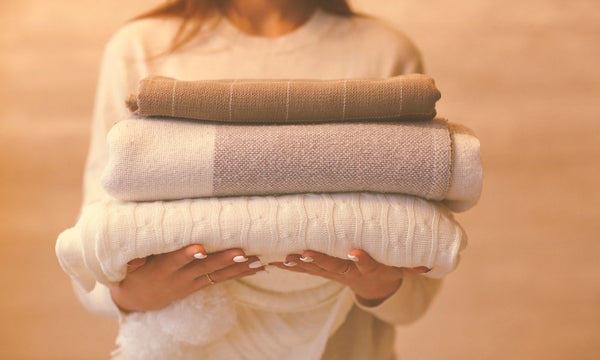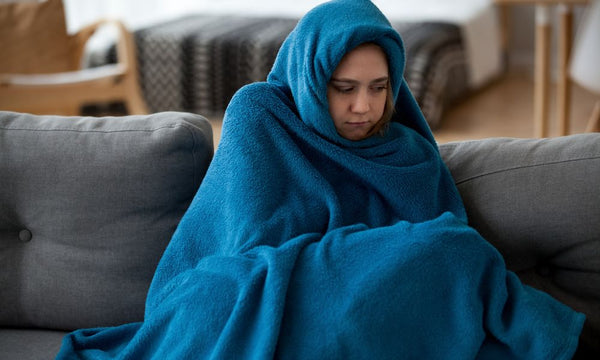What are the warmest materials and materials that keep you warm ?
When winter arrives, it is essential to stay warm. The question of which material keeps you warmest often arises, particularly for clothing. In this article, we'll explore different insulating materials and how they can help you stay warm during the cold months.

Natural materials and natural fabrics
Good news: natural materials are perfect for people with sensitive skin, looking for softness and insulation to warm the body in winter, even in high altitude. Here is our analysis and our advice.
Wool: a warm material
wool is a natural material which offers excellent thermal insulation. It is soft, comfortable and breathable, making it an ideal choice for winter clothing. In addition, wool retains its insulating properties even when wet.
Cotton: a widespread material
cotton is a very versatile natural material, used in many clothing and accessories. Although less insulating than wool or down, cotton can still help keep you warm when combined with other materials. Cotton is also soft and breathable, making it a comfortable choice for winter clothing.
Goose down: a rare material
goose down is another natural option to keep you warm. It offers greater thermal insulation than wool, but it is also more expensive: the rarity of this material unfortunately comes at a price! Goose down, stuffed with goose feathers must be kept dry to maintain its insulating properties. Discover why use a blanket to keep you warm in winter.
Duck down: an insulating material
duck down is a little less insulating than goose down, but it still offers excellent protection against the cold. It is also more affordable than goose down. As with goose down, it is important to ensure that the down remains dry to maintain its insulating properties. To learn more about the differences between throws, check out this article on which throw is warmer ?
Linen: an off-season material
linen is another natural material often used in clothing. Although it is usually associated with summer clothing due to its lightness and breathability, linen can also be used to create warm and comfortable winter clothing when mixed with other materials, such as wool or cotton. A suit that keeps you warm and avoids overheating in the off-season.
Cashmere: a noble material
cashmere is a luxurious and warm material made from cashmere goat hair: Angora goat, Mongolian goat. It is extremely soft, lightweight and offers excellent thermal insulation. However, cashmere is also expensive due to its rarity and delicate manufacturing process.ps, due to its ability to retain heat.
Does cashmere keep you warm ?
Cashmere is indeed very appreciated for its softness, its lightness and its exceptional insulating properties.
Because of its ability to retain heat while remaining lightweight and comfortable, cashmere is often used in the making of sweaters, scarves and other luxury winter accessories like the jacket. cou. Although cashmere is generally more expensive than other natural or synthetic materials, it offers a luxurious, warm experience that is worth the investment for those looking for a high-end garment.

Synthetic materials and synthetic fabric
Polyester fibers: a known material
polyester fibers are synthetic materials widely used to make winter clothing. This material is less expensive than natural fibers, but still offers good thermal insulation for their price. In addition, it resists humidity better than natural materials.
Discover our article in detail here: does 100% polyester keep you warm ?
Polyamide fibers: a controversial material
polyamide fibers, like nylon, are also used in the manufacture of winter clothing. They are light, resistant and offer good thermal insulation. However, they are less breathable than natural fibers, which can cause a feeling of dampness when worn for a long time.
Also read: polyester or polyamide, how to choose ?
Acrylic: hot or not ?
acrylic is a synthetic material that is often used as an alternative to wool in the manufacture of winter clothing. It is generally less expensive than wool and other natural materials, while providing similar thermal insulation.
Advantages of acrylic
Acrylic has several advantages over wool, including its resistance to moisture and ease of maintenance.
Clothes made from acrylic are generally easier to wash and dry than those made from wool, making them a practical choice for many people. Additionally, acrylic is less likely to cause skin irritation, which may be a benefit for those with sensitive skin.
Disadvantages of acrylic
Please note, however, that note that acrylic is less breathable than wool and other natural materials, which can result in a damp feeling and sweating when worn for long periods of time.
In addition, acrylic is often considered to be less durable than wool and may lose its shape or elasticity over time.
Velvet: a popular material
velvet is a soft, thick fabric, often made from synthetic fibers or cotton. This material is popular for winter clothing due to its ability to retain heat and provide luxurious comfort.
Viscose: an affordable material source of heat
viscose is a semi-synthetic fiber made from cellulose, often used to create soft, silky fabrics. Although less insulating than some of the other materials mentioned, viscose can be mixed with other fibers to create comfortable and warm winter clothing.
Also read: Is viscose warm for winter ?
Other insulating materials
Other insulating materials can also be used to keep you warm, such as silk, mohair or bamboo fibers. Each of these materials has specific advantages and disadvantages, so it is important to choose the one that best suits your needs.

Factors to take into account
When choosing clothing to protect yourself from the cold, it is important to consider several factors, such as the level of thermal insulation, breathability, water resistance and budget. Here are some tips to help you make the right choice:
- Evaluate your needs: Depending on the activity carried out and the climatic conditions, you will need a different level of thermal insulation. Adapt your choice based on these factors.
- Opt for layered clothing: Layered clothing allows you to easily adjust your warmth level by adding or removing layers.
- Consider breathability: To avoid sweating and discomfort, choose materials that allow moisture to escape.
- Check water resistance: If you expect to be exposed to moisture, opt for clothing that is water-resistant and quick-drying.
- Prioritize comfort: Make sure the clothes you choose are comfortable to wear and do not restrict your movements.
If you are looking for one or more plaid sweaters, find out which snuggle hoodie to choose.
Why use a hot material ?
It is important to use clothing that keeps you warm during the cold months for several reasons. Clothing made from warm natural materials or synthetic materials offers protection against low temperatures, thus guaranteeing your comfort and well-being.
Protection against the cold
The main advantage of using a warm fabric is that it protects you from the cold. Insulating materials trap body heat, creating a thermal barrier that prevents the cold from penetrating. This helps maintain a stable body temperature, even when outside temperatures are low.
Comfort and well-being
Warm clothing offers a higher level of comfort than thin clothing. The natural materials and synthetic materials used to make warm clothing are often soft and pleasant to the touch, which makes them more pleasant to wear. Additionally, by keeping your body at a comfortable temperature, you avoid feelings of cold and discomfort that can occur when you are exposed to low temperatures.
Prevention of health problems
Wearing clothing that keeps you warm can also help prevent certain cold-related health problems. Prolonged exposure to cold can cause frostbite, frostbite and even hypothermia. By using warm material to protect yourself from the cold, you reduce the risk of developing these health problems.
Performance and productivity
Finally, wearing warm clothing can improve your performance and productivity during outdoor activities in winter. When your body is well protected against the cold, you can concentrate more on your work or leisure activities, without being distracted by feelings of cold or discomfort.
It is essential to use clothing made from warm materials to protect yourself from the cold, improve comfort and prevent health problems linked to low temperatures. Whether you opt for natural or synthetic materials, make sure you choose clothing that suits your needs and the climatic conditions you will face.

Which activities require hot material ?
Certain activities and situations require clothing that keeps you warm to ensure your comfort and safety. Here are some examples of activities where it is important to wear clothing with good thermal insulation.
Outdoor activities in winter
Winter sports, such as skiing, require warm clothing to protect you from the cold in winter. heat is essential to maintain your performance and avoid cold-related health problems. In this case, it is essential to invest in quality clothing adapted to the season and weather conditions.
Missions in cold environments
Certain occupations, such as construction workers or utility industry employees, may be required to work in cold environments. In this context, it is crucial to choose clothing that keeps you warm to ensure the safety and productivity of workers during their mission.
Outdoor relaxation activities
Even during relaxing outdoor activities, such as reading in a park in the fall, it may be necessary to wear warm clothing to stay comfortable. For example, a wool hat or scarf can be a great piece to add to your wardrobe to protect you from the cold.
Preparing for emergency situations
It's also important to have warm clothing on hand in case of emergency situations, such as a car breakdown or low heat in your home. Having a few warm items in your wardrobe can make a big difference to your comfort and safety in the event of the unexpected.
Make sure you have warm clothes suited to your needs and don't hesitate to make a wise purchase to complete your wardrobe.

Which warm clothing provides thermal insulation
To protect yourself from the cold and ensure good thermal insulation, it is important to choose the right clothing. Here are some examples of warm clothing that will help you stay warm on cold days.
Coats
coats are an essential part of your winter wardrobe. They are designed to provide optimal thermal insulation. When purchasing, look for coats with thick lining and quality construction to ensure they keep you warm. Prices vary depending on the quality and type of coat, but consider this purchase a long-term investment.
Sweaters and under-sweaters
The sweater and the under-sweaters are also essential clothes for winter. They can be worn alone or under a coat for an extra layer of warmth. Look for sweaters made from wool, cashmere or synthetic insulating fibers to ensure they keep you warm.
Thermal underwear
Thermal underwear is another option for staying warm during the winter months. These garments are designed to be worn under your regular clothing, providing an extra layer of insulation without adding bulk. You can find thermal underwear like the t-shirt made from wool, silk, or synthetic fibers, and they are often available for sale at affordable prices.
The snuggle hoodie
The snuggle hoodie or Hoodie Blanket is a versatile garment that combines the advantages of a sweater and a blanket. Designed to wrap you in warmth and comfort, the snuggle hoodie is perfect for cold days spent indoors or during outdoor activities. Made from soft, insulating materials, the snuggle hoodie is an ideal choice for those looking for an extra layer of warmth.
The Fleece Lined Tights
The Fleece Lined Tights is another option for those who want to stay warm during the winter months. These tights are designed with a fleece lining, providing superior thermal insulation compared to traditional tights. Perfect for wearing under skirts, dresses or even pants, fleece tights are a must-have for your winter wardrobe.
The dressing gown and the bathrobe
The dressing gown and the bathrobe are interior garments that provide warmth and comfort. These clothes are generally made from soft and warm materials, such as wool, cotton terry or synthetic fibers. The dressing gown and bathrobe are perfect for relaxing at home after a long day at work or for warming up after a shower.
Hats, scarves and gloves
Don't forget the accessories to complete your winter outfit. hats, scarves and gloves are essential to protect your head, neck and hands from the cold. As with other warm clothing, look for materials that provide good thermal insulation, such as wool, cashmere or synthetic fibers.
Also read: Synthetic or natural silk ?
Where to buy insulating clothing with warm material ?
In the world of fashion, there are many brands that offer warm clothing to help you stay comfortable during the cold months. Some of these brands specialize in creating high-quality winter clothing, while others offer a variety of styles and materials to suit every need.
The Oversized Hoodie
The Oversized Hoodie is a brand specializing in comfortable and trendy winter clothing. Their products are designed to keep you warm while providing a casual and elegant style. You can visit our website to take stock and discover their range of winter products and take advantage of their regular promotions and discounts.
Accessible brands
There are also many accessible brands that offer good value for money for winter clothing. These brands generally offer clothing at more affordable prices, which can make your winter shopping easier without sacrificing quality. Consult the catalogues online or visit the websites of these brands to discover their offers and compare prices: Action, Gifi, Centrakor, La Foir'Fouille, Carrefour
Luxury brands
If you are looking for high-end winter clothing, you can look to luxury brands that offer fashion items made with premium materials. Although these brands may be more expensive, they often offer a level of quality and durability that may be worth the investment.
Promotions and sales
To get the most out of your winter budget, keep an eye out for promotions and sales offered by your favorite brands. Many websites and stores offer seasonal discounts or flash sales that can help you save on your winter clothing purchases.
Don't forget to compare prices and take advantage of promotions to get the most out of your budget.

Maintenance and durability of insulating materials for clothing
Maintenance of your thermal clothing is crucial to preserve their insulating properties and extend their lifespan. Follow the manufacturer's care instructions and avoid using harsh chemicals that could damage the fibers. Additionally, be sure to dry your clothes thoroughly after washing them, as humidity can reduce their insulating capacity.
Sustainable development and insulating materials
The choice of durable and environmentally friendly insulating materials is increasingly important for many consumers. Look for eco-friendly certifications, such as the Oeko-Tex label or the Bluesign label, which guarantee that materials are produced responsibly and free of harmful substances. You can also opt for recycled materials or natural fibers from organic farming.
Verdict: which material keeps the warmest ?
In short, several materials can keep you warm during cold periods, whether natural materials like wool and down or synthetic materials like polyester and polyamide. To choose the right clothing, consider your needs, budget and comfort preferences. Don't forget to take good care of your thermal clothing and choose environmentally friendly materials. If you are looking for a Hoodie Blanket, see which Hoodie Blanket to buy.

FAQ
-
What is the best material to stay warm in winter ?
Natural materials such as wool and goose down are the best thermal insulators, while synthetic materials such as polyester and polyamide are often less expensive and are more resistant to humidity.
-
Is wool warmer than down ?
Both materials provide excellent thermal insulation, but down is generally considered warmer than wool. However, wool has the advantage of being more breathable and better resistant to humidity than down.
-
Is synthetic clothing cheaper than natural fiber clothing ?
Yes, synthetic clothing is cheaper than natural fiber clothing, because synthetic materials are less expensive to produce. However, prices vary depending on the quality and specific characteristics of the garment.
-
How to properly maintain my thermal clothing ?
To properly care for your thermal clothing, follow the manufacturer's care instructions and avoid using harsh chemicals that could damage the fibers. Also be sure to dry your clothes thoroughly after washing them, as humidity can reduce their insulating capacity.
-
How to choose environmentally friendly insulating materials ?
To choose environmentally friendly insulation materials, look for ecological certifications, such as the Oeko-Tex label or the Bluesign label, which guarantee that materials are produced responsibly and free of harmful substances. You can also opt for recycled materials or natural fibers from organic farming.
-
Does 100% polyester keep you warm ?
Yes, 100% polyester is a synthetic material that provides good thermal insulation, especially when used in winter clothing thick.
-
Does 100 cotton keep you warm ?
Yes, cotton is a natural material that can provide warmth, especially when used in thick or layered winter clothing. However, it is generally less insulating than some other materials.
-
What fabric to protect from the cold ?
Fabrics such as wool, goose down, duck down and certain synthetic materials such as polyester or polyamide are ideal to protect against the cold due to their ability to retain heat. Discover our complete guide to staying warm: what material protects from the cold ?
-
Which is warmer cotton or polyester ?
polyester is generally considered warmer than cotton because it retains heat better and resists moisture. However, cotton can also provide some warmth when used appropriately.
-
What material to wear when it's cold ?
To stay warm in cold weather, choose materials such as wool, goose down, duck down, or synthetic materials such as polyester and polyamide, which offer excellent thermal insulation.
Updated 19 March 2024








